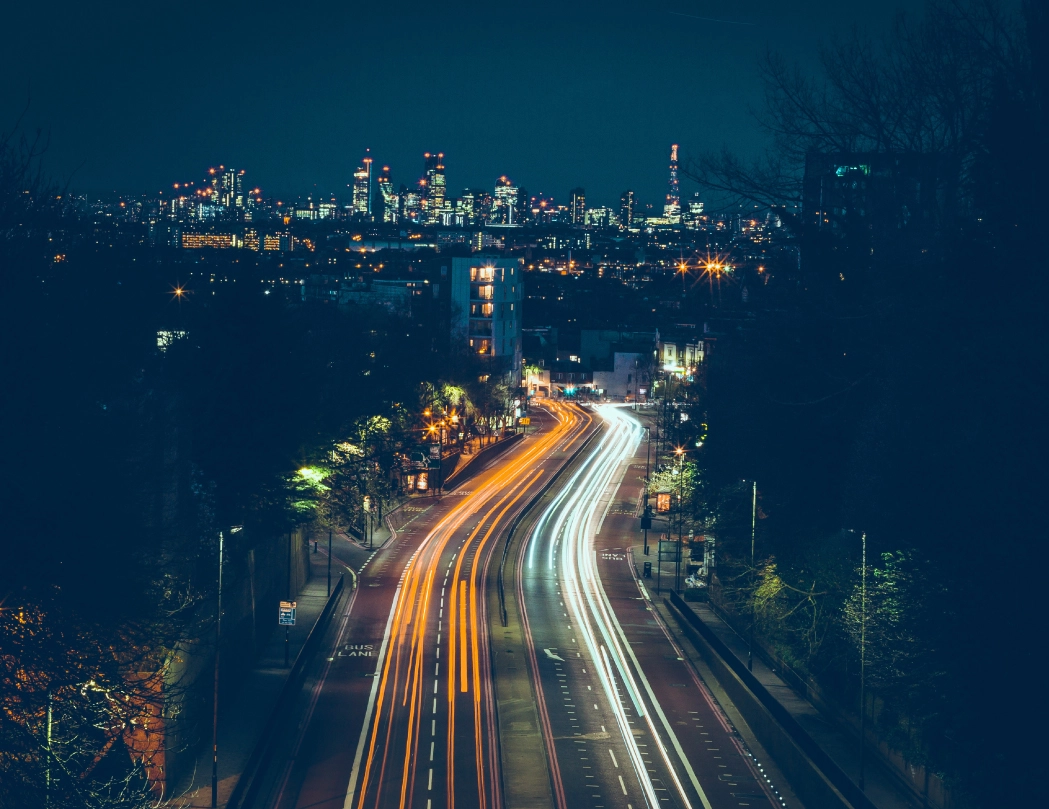Essential Preparations for Nighttime Journeys
Driving at night comes with its own set of challenges. Decreased visibility, increased fatigue, and the potential for unexpected hazards all contribute to higher risk on the roads after dark.
This guide will provide essential tips for staying safe during those nighttime journeys and offer expert advice on what to do if you're involved in a non-fault accident in these conditions.
Prepare Yourself and Your Vehicle for Safe Night Driving
Driving safely at night isn't just about what you do behind the wheel; it starts with taking steps to optimise both your vision and your vehicle's condition
Eyes on the Road
Good vision is always key for safe driving, but at night, it's what keeps you safe. Regular eye exams are your best bet.
They ensure you have an accurate prescription and help catch early signs of conditions that can worsen night vision, like cataracts or glaucoma.
Even if you believe your vision is perfect, consider having a checkup optimised for nighttime driving needs. Your eye doctor can offer recommendations for:
- Anti-reflective lens coatings: These reduce distracting glare from headlights and streetlights.
- Night-specific prescription adjustments: Some individuals may benefit from slight prescription tweaks to optimise their vision in low-light conditions.
Keeping Windshield, Headlights, Taillights, and Mirrors Clean
It might seem obvious, but a surprising number of drivers underestimate how much grime can build up on their car's exterior, significantly impacting nighttime visibility. Here's why clean glass and lights matter:
- Improved Visibility: Dirt, smudges, and bug residue scatter light, creating a haze that makes it harder to see obstacles and other drivers.
- Reduced Glare: Clean surfaces minimise glare from oncoming headlights and streetlights, helping you see more clearly.
- Accident Evidence: After an accident, clean lights and windows aid in capturing accurate photos and details needed for your case.
Check Your Lights
Well-functioning and correctly aligned headlights are vital for seeing and being seen on nighttime roads. Here's what to focus on:
- Visibility: Can you see far enough ahead to react safely? If your headlights seem dim or if the beams only illuminate a short distance, consider replacing the bulbs.
- Alignment: Misaligned headlights don't just reduce your own visibility; they can also blind oncoming drivers, creating a hazard. Most garages offer quick headlight alignment checks.
- Rear Lights and Indicators: Don't forget about the back of your car! Ensure your rear lights, brake lights, and indicators are all working and clearly visible.
Dim the Dashboard
You'd be surprised how much even a moderately bright dashboard can interfere with your night vision. Here's why dimming those lights matters:
- Reduced Eye Strain: Bright dashboards force your pupils to constrict, making it harder to adjust to the darkness outside your car. Dimming allows your eyes to adapt more comfortably.
- Improved Visibility: Excessive dashboard light creates reflections on the inside of your windshield, obscuring potential hazards on the road.
- Easier Focus: Dimming your dashboard reduces distractions, letting you fully concentrate on navigating safely.


Speak to a Non-Fault Claim Specialist
We manage everything on your behalf, ensuring that the claims process is as smooth and stress-free as possible.
Back to the top >

Master Nighttime Driving Techniques
Nighttime driving presents a unique set of challenges, from reduced visibility to increased potential for unexpected hazards.
Slow and Steady
Nighttime driving presents challenges due to reduced visibility and slower reaction times. To increase safety, reduce your speed. This allows you more time to react to potential hazards and lessens the severity of potential accidents.
- More Reaction Time: Slower speeds give you extra seconds to spot hazards like pedestrians, animals, or unexpected obstacles. This additional time is important for making safe decisions and potentially avoiding a collision.
- Reduced Impact: In the unfortunate event of an accident, lower speeds lessen the force of impact. This can make a huge difference in both the extent of vehicle damage and the potential for injuries.
- Accident Evidence: Maintaining a responsible, situationally-appropriate speed is always important, but even more so at night. In the event of a non-fault accident, it helps establish that you were driving cautiously, potentially strengthening your claim.
Space Matters
Increase the following distance between your car and the one ahead for safer nighttime driving. There are several reasons why this is important:
- Improved Reaction Time: Limited visibility reduces your ability to judge distances accurately and react to sudden changes. Increased following distances create a buffer zone, giving you those extra seconds to avoid a collision or minimise the impact.
- Reduce Glare: Avoid blinding the driver in front of you by increasing the space between your cars. This reduces the intensity of your headlights reflecting off their vehicle, allowing them to see the road more clearly.
Strategic Lighting
High beams can be a lifesaver when used correctly at night, but it's important to use them responsibly to avoid blinding other drivers. Here's how to strike the right balance:
When to Use High Beams
- Truly Dark Roads: High beams significantly improve visibility on unlit rural roads when there's no oncoming traffic or cars ahead of you.
When NOT to Use High Beams
- Oncoming Traffic: Dip your high beams immediately when you see headlights of an oncoming car. This prevents temporarily blinding them and causing a dangerous situation.
- Following Other Vehicles: High beams shining in the rearview mirror of the car ahead are distracting and rude. Switch back to low beams well before getting too close.
- Well-Lit Areas: High beams are unnecessary and inconsiderate in towns, cities, or anywhere with streetlights.
Scan and Anticipate
Safe night driving means more than just watching the road ahead. Be aware of your surroundings and anticipate potential dangers to stay safe. Here's how to improve your nighttime observation:
- Scan Far and Wide: Don't just focus on the road directly in front of you. Scan further ahead, to the sides of the road, and check your mirrors frequently. This helps you spot potential hazards early.
- Look for Movement: Pay extra attention to shadows, flickers of light, or anything that seems out of place. This could indicate animals about to cross, pedestrians, or cyclists who may be harder to see.
- Anticipate the Unexpected: Think ahead about what other drivers might do, and be prepared for sudden lane changes, or cars emerging from side streets. Assume pedestrians may step out unexpectedly, especially in dimly lit areas.
- Know Your Blind Spots: While mirrors can't eliminate blind spots entirely, checking them regularly helps you minimise them. This allows you to react more quickly if another road user, like a car, motorbike, or cyclist, moves up beside or behind you.
Managing Glare
Glare from headlights, streetlights, and reflective surfaces is common at night and can reduce visibility. Here's how to minimise the impact:
Prevention Techniques
- Clean Windshield: A spotless windshield (inside and out) reduces glare.
- Dim your dashboard lights: Turn them down so they're not too bright, but you can still see your instruments.
- Rearview Mirror Adjustment: If your car has a manual dimming lever, use it to deflect glare from cars behind you.
When Glare Happens
- Glance away: Don't stare directly at the source of the glare.
- Shift your focus: Briefly look at the right side of the lane marker or the road edge.
- Slow down: Reduce your speed slightly to give yourself extra reaction time.
- Pull over if needed: In severe cases, find a safe place to pull over until your vision is clear.


Speak to a Non-Fault Claim Specialist
We manage everything on your behalf, ensuring that the claims process is as smooth and stress-free as possible.
Back to the top >

Fight Fatigue for Safer Journeys
Drowsiness is a major hazard when driving at night. Even short journeys can become dangerous if you're tired. Here are some tips to help you stay alert and arrive safely:
Know the Signs
Fatigue can creep up on you quickly, especially at night when your body naturally wants to rest. Recognising the early warning signs is important for minimising the risk of falling asleep at the wheel. Take a break if you start to experience:
Physical Symptoms:
- Heavy eyelids, frequent blinking, or difficulty focusing your eyes.
- Repeated yawning or trouble keeping your head up.
- Restlessness or fidgeting in your seat.
Mental Symptoms:
- Difficulty remembering the last few miles driven.
- Daydreaming, wandering thoughts, or disconnected feelings.
- Missing road signs, turns, or exits.
Behavioural Changes
- Drifting out of your lane, driving too close, or varying your speed unintentionally.
- Shortened temper with other drivers.
Refresh and Recharge
Nobody's immune to getting tired on night drives. The key is to stay one step ahead! Regular breaks will keep you alert, and they don't have to be a big time commitment to make a difference.
Break It Down:
- Stay Fresh: Take breaks regularly to keep focused and refreshed while driving.
- Actually Get Out: Don't just sit in the car! Stretch, take a quick walk. Fresh air does wonders.
- Smart Refreshments: A bit of caffeine (coffee, tea) is fine, but don't rely on it all night. Water keeps you hydrated and focused, and a handful of nuts is better fuel than sugary snacks.
Safety Matters:
- Be Smart About Stops: Rest areas are best, but if you need to pull over, make sure it's safe and well-lit.
- Shoulders Are Off-Limits: It might be tempting, but it's incredibly dangerous, especially at night.


Additional Night Driving Considerations
Nighttime driving brings a unique set of challenges, and we've covered the core techniques for safety. But there are a few more factors to consider for a safer experience on dark roads. This section will delve into those extra considerations.
Watch for Wildlife
Animal crossings pose a serious risk at night, especially in rural areas. Stay safe with these key tips:
- Be Aware: Pay extra attention at dawn, dusk, and in areas marked with wildlife signs.
- Scan Ahead: Actively look for movement or eye reflections along the roadsides.
- Slow Down: Reduce your speed, especially in high-risk zones, for better reaction time.
- Brake, Don't Swerve: Maintain control if an animal is in the road. Swerving is often more dangerous.
- Report Collisions: If you hit an animal, pull over safely and contact the police.
Dealing with Other Drivers
Night driving means sharing the road with potentially tired, impaired, or less visible road users. Protect yourself with these tips:
- Defensive Driving: Don't assume other drivers will follow the rules. Be extra careful at junctions and steer well clear of anyone driving dangerously.
- Watch for Impairment: If someone is driving recklessly, maintain distance and report dangerous behaviour to the police.
- Look Out for Others: Pedestrians and cyclists are harder to see at night. Slow down in built-up areas and use high beams responsibly.
Accident Preparedness
Accidents are stressful, and the dark adds another layer. Focus on these key actions to stay safe and protect your rights:
Immediate Steps:
- Safety First: Move to a safe spot if possible. Turn on hazards, assess injuries, and call emergency services if needed.
- Gather Evidence: Note the location, time, and cause of the accident. Take photos of damage, license plates, and the scene.
- Exchange Info: Get names, insurance details, and contact info from all involved parties, including witnesses.
Explore our comprehensive guide for detailed instructions on what to do after a car accident.


Auto Claims Assist
First contact after a car accident
Start my claim online Call us on 0330 128 1407